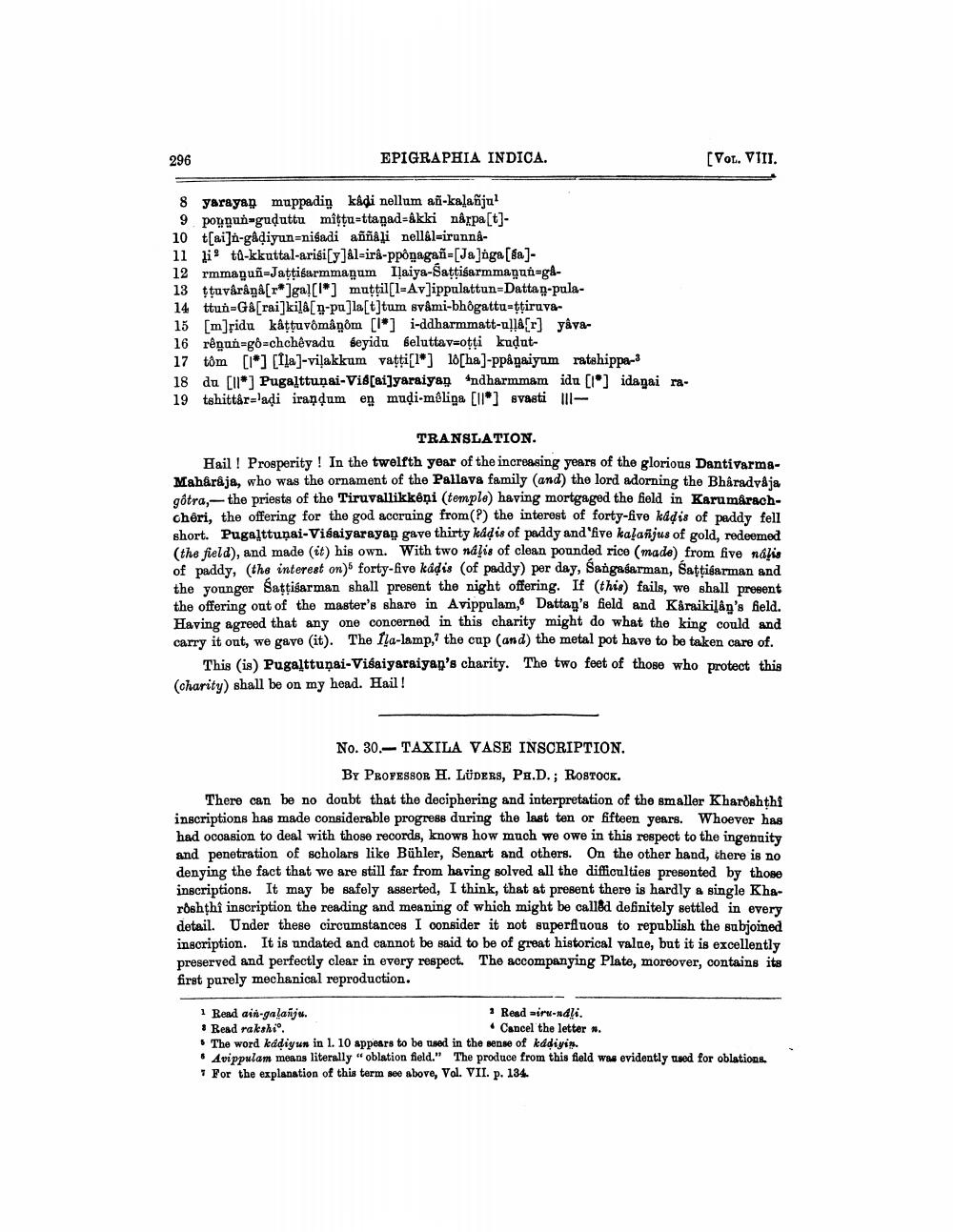________________
296
EPIGRAPHIA INDICA.
[Vol. VIIT.
8 yarayap muppadiņ kadi nellum añ-kalanju? 9 pongun-guduttu mittuættanad=&kki nêrpa[t]10 tsai]n-gadiyun-nisadi aññali nellkl-irunn - 11 lita-kkuttal-arisi[y]&l-ira-ppÔnagañ=[Janga[fa]12 rmmagun-Jattiśarmmanum Ilaiya-Sattisarmmagun-gl13 ţțavárânå[r*]ga!(l') muttil(1-Av]ippulattun-Datta p-pala14 ttun-G8[rai]ki!A[9-pa]la[t]tum svâmi-bhôgattuættiruva15 [m]pidu kattuvômânom [lo] i-ddharmmatt-u!]A[r] yava16 rêuń=go=chchêvadu seyidu Beluttav=otti kudut17 tôm [1] [[la]-vilakkum vatti[l] 18[ha)-ppågaiyum ratehippa-3 18 du [ll] Pugalttunai-Vid[ai]yaraiyan 'ndharmmam idu [lo] idagai ra19 tshittar 'adi irandum en muļi-mbliga [11] svasti lll
TRANSLATION. Hail ! Prosperity! In the twelfth year of the increasing years of the glorious DantivarmaMahåråja, who was the ornament of the Pallava family (and) the lord adorning the Bharadyája gôtra, the priests of the Tiruvallikkêņi (temple) having mortgaged the field in Karumärachchêri, the offering for the god accruing from(?) the interest of forty-five kadis of paddy fell short. Pugalttunai-Visaiyarayap gave thirty kädis of paddy and five kafatljus of gold, redeemed (the field), and made (it) his own. With two nális of clean pounded rice (made from five nalie of paddy, (the interest on) forty-five kadis (of paddy) per day, Sangasarman, Sattisarman and the younger Sattisarman shall present the night offering. If (this) fails, we shall present the offering out of the master's share in Avippulam, Dattan's field and Karaikilay's Bela. Having agreed that any one concerned in this charity might do what the king could and carry it out, we gave (it). The Ila-lamp, the cap (and) the metal pot have to be taken care of.
This (is) Pugalttunai-Visaiyaraiyap's charity. The two feet of those who protect this (charity) shall be on my head. Hail!
No. 30.- TAXILA VASE INSCRIPTION
BY PROFESSOR H. LÜDERS, PH.D.; ROSTOCK. There can be no doubt that the deciphering and interpretation of the smaller Kharðshthi inscriptions has made considerable progress during the last ten or fifteen years. Whoever has had occasion to deal with those records, knows how much we owe in this respect to the ingenuity and penetration of scholars like Bühler, Senart and others. On the other hand, there is no denying the fact that we are still far from having solved all the difficulties presented by those inscriptions. It may be safely asserted, I think, that at present there is hardly a single Kharoshthî inscription the reading and meaning of which might be called definitely settled in every detail. Under these circumstances I consider it not superfluous to republish the subjoined inscription. It is undated and cannot be said to be of great historical value, but it is excellently preserved and perfectly clear in every respect. The accompanying Plate, moreover, contains its first purely mechanical reproduction.
1 Read aia-galanja.
* Read Diru-ndļi. • Read rakshio.
• Cancel the letter .. The word kddiyun in 1. 10 appears to be used in the sense of kddiyin. • Avippulam menns literally "oblation field." The produce from this field w
For the explanation of this term se above, Vol. VII. p. 134.
evidently used for oblations




